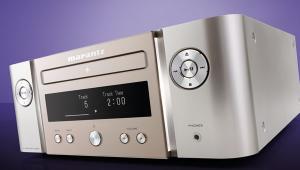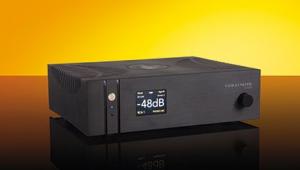Meridian Audio Core 200 & DSP3200 - £5,250

Meridian Audio is a highend company with a difference, its products are largely dependent on being used within a complete Meridian system in order for them to be able to do everything in an extensive list of features.
The new DSP3200 is the least expensive active speaker in the range and it has been designed to be exclusively used with one of the company’s control units, be that a preamp/processor, CD player or a Sooloos music server. It has the same proportions as the mid-treble part of the range-topping DSP8000, but contains completely different drivers and electronics. It’s the latter that mark this out as not merely an active speaker, but a DSP-controlled design where everything is done in the digital domain. The Audio Core 200 pre/processor is the most affordable entry point to Meridian control. It’s effectively a preamplifi er, albeit one with analogue, digital and dock inputs and outputs that are dedicated to Meridian active speakers.
Room-correcting systemThe DSP3200 speaker has more functionality than almost any other active design we’ve reviewed. It gives end users enormous flexibility when it comes to installing the speaker in the modern home, where there are always factors that undermine optimal positioning.
Other manufacturers make room correction processors that combine with passive loudspeakers, but this introduces an extra variable over the Meridian model, because the processor has to compensate for the nonlinearities in the speaker and in the room. In many ways the Audio Core 200 and DSP3200 form a roomcorrecting system. They don’t measure the response of the room and try to compensate for its irregularities, but the amount of set up variation they offer allows the user to tailor the fi nal balance to a similar degree.
The Audio Core 200 can be used to adjust the DSP3200’s balance, so that it will work either in free space, against a wall, on a bookshelf or even in a corner where bass is naturally amplified. And if you prefer there is the option of adjusting tonal balance with a Baxendale-style tilt control, which offers considerably more subtlety than the usual bass and treble approach.
Another common problem is that you can’t always sit in the optimal stereo sweet spot. The Meridian approach is to use a bit of level change with a lot of time delay, fractionally holding back the output of the nearest speaker to create the effect of both speakers being the same distance away.
The DSP3100, which preceded this speaker, took a different approach to putting Meridian technology into a relatively affordable active speaker, it was housed in a less-expensive, conventionally shaped box, albeit with aluminium side panels. But it was equipped with S/PDIF digital inputs alongside the SpeakerLink system. There was also an analogue version (M3100), with a balanced input. For the DSP3200, Meridian has stuck with its preferred cabinet design, but omitted non-key features such as an S/PDIF input, display and infrared remote interface of the 3100. The Audio Core 200 is, therefore, essential for use with this speaker because it supplies signal via Meridian’s SpeakerLink system ofCAT6 cable on RJ45 plugs. The Core 200 controls the speaker’s features via a simple remote control and front panel buttons that allow you to access the positioning and widthcontrol options. The inputs include two 3.5mm mini-jack sockets that accept both analogue and optical digital inputs. There is also a minijack headphone output on the back and an mini-DIN input dedicated to the i80 iPod dock. Analogue inputs are converted to digital and whole integer upsampled to a maximum of 96kHz.
Optimising digital signalsThe Audio Core 200 doesn’t merely convert and upsample incoming signals, it also uses Meridian’s apodising fi lter to ‘clean up’ the sound (as the specs put it). Essentially, it eliminates ringing in brickwall filters, which is defi nitely a good thing. This unit is designed to make the most out of all digital signals be they from a CD transport, a music fi le on the computer or something as prosaic as a YouTube stream. It’s a real world processor that aims to get as much music as it can out of any signal, whatever the quality.
The iPod dock may not offer a digital output, but it allows the Audio Core 200 to display metadata, which means that you can search and play from the listening seat with the remote, its logic takes a bit of familiarisation but is probably child’s play.
It’s surprisingly lightweight, this is partly because its switching power supply sits in a wall wart plug, but also because it has a relatively small, but beautifully executed mouldedresin case, with a deep, piano-black finish. Build is clearly first class and design of a standard rarely encountered in this business.
The DSP3200 is also a superbly put together product, its made of pressure laminated, birch ply panels sourced from slow growing, highaltitude trees, because this variety is more stable. The white lacquer is so perfect that you’d never guess that there’s any wood underneath and yet acts to make the cabinet that bit more rigid. Inside the box there are two 75-watt power amps, one for the polypropylene bass driver and one for an aluminium cone mid/treble unit. This is, therefore, a full-range unit coupled with a woofer, rather than a tweeter and mid/bass pairing usually found in two-ways – the crossover point is at 400Hz.,
Free space
The DSP3200 speaker has a matching stand which is, as is the Meridian style, carefully designed for maximum domestic acceptability, yet manages to be practical as well; in this case a single polished leg supports the top plate and hides both signal and mains cables, which connect to the speakers base and thus remain out of view.
We bolted the speakers onto these stands, hooked up with the supplied 10m lengths of CAT6 and were virtually there. It’s a simple system that can be expanded with various Meridian Sooloos components to cater for up to a dozen sources, but for the purposes of the review we used a Leema Antila CD player’s digital output, an Apple iMac and an iPod Touch.
Setting up the speakers is more fl exible than usual, thanks to the DSP3200 positioning options, but if you have no limitations then free space is the way to go because it allows for natural imaging without the need to use DSP. We did try out the ‘width’ feature, however, and it makes a distinct difference to the end result, so it’s easy to see that in a compromised speaker position you would not have to put up with restricted soundstage scale. In standard set-up this is a highly revealing system that digs out detail like few others, it is extremely good at low-level resolution and manages to unearth fi ne sounds that more expensive amplifi er and speaker combinations fail to reveal. This is the advantage of keeping the signal in the digital domain for as long as possible – right through the crossover and up to the power amplifi er – and using amplifi ers that have a direct connection to the drive units.
While 75 watts may not sound like a great deal, remember that this is per driver, so in practice you have 150 watts a side. It’s not an obviously pacey sound, but there’s no getting away from the depth of bass that’s on offer and the alacrity with which it can be manipulated. It’s probably why this system is so revealing of things like phase (spatial and sonic modulations which we’ve rarely encountered before) and bass power.
We hooked up the i80 iPod dock to test the system’s skills at brushing up less than spectular MP3 material. While there is still a big difference between high and low-res bit rates, even the lowliest are very listenable. One interesting example is a voice and sax piece by Jack Kerouac and Zoot Sims, as the speaker’s lack of a crossover in the midband makes for very low coloration which gives voices a depth of character that’s rare.
Icing on the cakeMeridian is not your run-of-the-mill hi-fi manufacturer, it’s out to bring good sound quality to people who want to enjoy music with the minimum of wires and frippery. That it can do this in a very attractive package that delivers a highly resolute sound is impressive indeed. The fact that these components cannot be mixed and matched is a major reason why it does this so successfully. It’s a well thoughtout solution to the music lover’s needs and the fact that it’s a British company with considerable technological clout is the icing on the cake.
LIKE: Excellent detail, beautiful finish and surprisingly powerful
DISLIKE: iPod interface takes a bit of getting used to
WE SAY: A well thoughtout system that should win Meridian a lot of fans, even if it doesn’t fit into the standard separates model
PRODUCT:
Meridian Audio Core
200/DSP3200
ORIGIN: UK
TYPE:
Processor
preamp and
active speakers
WEIGHT:
DSP3200 8.5kg
Audio Core 200 2.7kg
DIMENSIONS:
Audio Core 200
(WxHxD)
280x91x280mm
DSP3200 (WxHxD)
244x320x246mm
FEATURES:
(Audio Core 200)
• Digital inputs: 2x
coaxial, 2x minioptical,
USB,
• Analogue inputs:
2x RCA phono, 2x
mini-jack, i80
• Outputs: Meridian
SpeakerLink,
headphone mini-jack
(DSP3200)
• 2-way sealed
enclosure
• Drivers:
bass – 165mm
polypropylene,
mid/treble – 85mm
aluminium cone
DISTRIBUTOR:
Meridian Audio
TELEPHONE:
01480 445678
WEBSITE:
meridian-audio.com
 |
Inside this month's issue:
Q Acoustics 3020c standmount loudspeakers, Perlisten R10s active subwoofer, Quad 33 and 303 pre/power amps, Acoustic Solid Vintage Full Exclusive turntable, newcomer Fell Audio Fell Amp and Fell Disc and lots, lots more...
|




















































